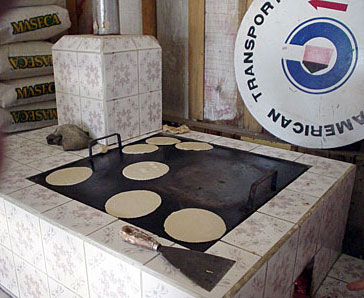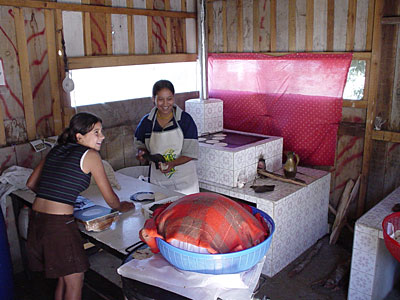

TILED JUSTA STOVES, AHDESA, Honduras
Damon Ogle, March 2003
 |
 |
These stoves are part of an AHDESA (Honduran Association for Development) stove project near Tegucigalpa. Trees Water People , based in Fort Collins, Colorado runs stove projects
in several countries, including Honduras, El Salvador and Guatemala. AHDESA is their local partner in Honduras. In El Salvador and Guatemala , they work with
other organizations. Our (Aprovecho) work in all three countries was made possible by Stuart Conway and his organization TWP. See: http://www.treeswaterpeople.org/Honduras.htm
The stove pictured is only one of several stoves in the area which had been tiled or improved in other ways. I don't know how much the tiling cost, but I
sespect it was minimal as ceramics are very inexpensive in the area. Dean has a cd with pictures of other stoves in and around Tegucigalpa which have been
embellished in different ways. People are proud of their stoves and want to show them off.
Total cost of basic stove is about $60. This breaks down to:
The family must also build a suitable platform for the stove and provide some basic materials and unskilled labor for the mason. Rotary is
involved in some projects and I think they and Ahdesa subsidise about half of the cost of the basic stove. Bells and whistles (in this case tiles) are paid for by
the stove owners. In this case the tortilla lady's husband did the tile work on his own.
The technicos (stove masons) are able to do about two stoves a day and they have 4 or 5 techincos working now. I'm not sure of total numbers but I
think two or three thousand have been built in neighborhoods around Tegucigalpa in the last couple of years.
No hard numbers on wood savings, but the lady whose stove is pictured claims that her wood costs went from 280 limpiras per day down to 30 or
40 per day after she installed the stoves, (I think there are about 8 limpiras to the dollar). She has three stoves (only the first of which was subsidized) and about 6 womenare employed making tortillas for the market, so the stoves are burning all day long.
Most house wives (cooking for meals only)will tell you that they use 1/3 of the fuel they used before. These are probably WAGs but I believe the savings are at least 50%.
There is a hot spot , but the entire surface seems to remain hot enough to cook tortillas. They have learned to juggle the tortillas so that they don't burn.
The top of the rocket elbow is about 2" below the bottom of the plancha. The insulation is wood ash and when installed is beveled up to about
1" below the plancha for most of the path. Ash tends to settle and in most of the older stoves we inspected the gap was greater we wanted to see. Maintaining the proper gap
is a problem for which we have not yet found a good solution.
Don O'Neil uses a version of the inverted pyramid in his Helps Stove in guatemala. The side of the elbow toward the chimney is about 2"
lower than the rest of the elbow sides and a gradual "ramp" slopes up to a 1" gap below the plancha at a point about 2/3 of the way to end of the plancha. He uses pumice for
insulation and gets a much better heat distribution using this configuration.
A couple of other observations.
This is hard to quantify, but the quality of life goes way up for people using the "justas". Before the stove is installed, the kitchens tend to be
dark, and grimey with lots of sooty cobwebs everywhere. Everything including the cook and her clothing are sooty and smell of smoke. After the stoves are installed, the
cooking areas ted to get cleaned and painted and both clothing and attitudes tend to be brighter.
I don't know about CO emmisions, but visually the stoves seem to burn very clean. When you look at the chimney from outside the house it is almost impossible to tell
whether the stove is burning or not. If you look very closely you can see the heat waves.
These are very good stoves, but the target group seems to be a somewhat middle class family (by C.A.standands). I certainly think we should continue to build as many
"justas" as possible, but we should also try to target the poorer part of the population by developing a much cheaper simple stove for people who will never be able
to afford a $60 stove.
Damon